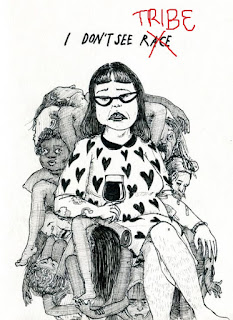NEW YORK TIMES DECRIES CENSORSHIP
 |
| Image Credit: Jim Chuchu |
In what can only be termed as the worst attack on the media since the Charlie Hebdo shooting, New York Times were asked to account for their actions.
Furore erupted online after the New York Times published graphic photos of dead Kenyans immediately after the Riverside terrorist attack happened in Nairobi, Kenya, while the rescue operations were still ongoing and families of victims hadn't yet been notified. There was an immediate call for the media house to pull down the photos and the incident sparked a discussion over the callousness with which black and brown bodies are used for the consumption of the white gaze
 | |
|
The international media world came out in their defense and didn't understand where this sudden unwarranted call for accountability came from and promised to fight for the reckless media freedom that their ancestors fought for.
"We can't believe that it's coming to this. We thought that Nairobi was more advanced than these other African countries but it seems not " mused the African Bureau Chief, based in New York.
In an unsigned editorial addressing the uproar, the New York Times sought to assure its readers that it has a stringent set of in-house checks and balances to ensure sensitivity and fairness. The response quoted assurances from their African friend, Kwame and they also gave links to three stories spaced out over 30 years where they showed white bodies.
In an unsigned editorial addressing the uproar, the New York Times sought to assure its readers that it has a stringent set of in-house checks and balances to ensure sensitivity and fairness. The response quoted assurances from their African friend, Kwame and they also gave links to three stories spaced out over 30 years where they showed white bodies.
 | |
|
The atmosphere was tense in several luxury hotels and upscale restaurants in Nairobi in the wake of the troubling demands for accountability with the foreign correspondents sharing horror stories of different countries in the world where they have faced questions over their work and how that scarred them. They verbalized their fear of consequences and assured each other of support in case any other journalists faced the same unnecessary questions.
Several outspoken academics and authors went on to educate Kenyans on what the real issues were that they should be focused on upon the realisation that Kenyans needed their intellectual assistance.
They asked Kenyans to consider the feelings of the incoming East Africa Bureau Chief, Kimiko de Freytas-Tamura whose only crime was to love Africa and who is trying to tell the real African story.
"The rise of feedback is at odds with the democracy that many of these countries from the Global South stand for. We only published the pictures to give an accurate reflection of the situation on the ground and white people can't understand black death without graphic and tasteless images. It's that simple" read the third response by the New York Times.


He says, not daring to use his real name. Peak maturity.
ReplyDeleteThis comment has been removed by the author.
ReplyDeleteAnnemarie unaropokwa juu amesema women who keep screeching about men who pumped and dumped them? What a harlot
ReplyDelete